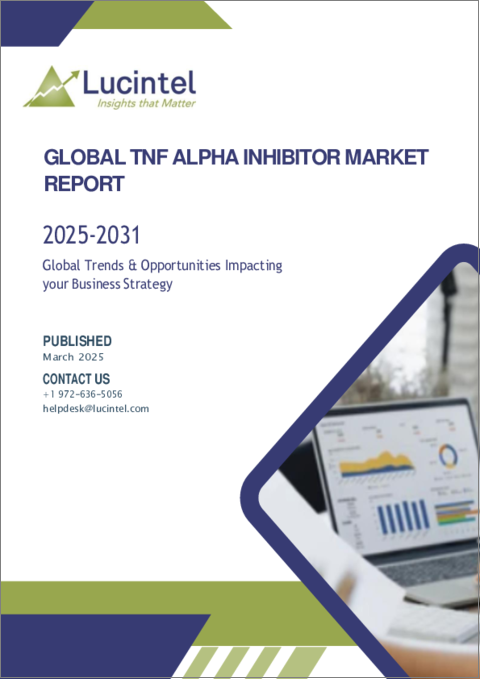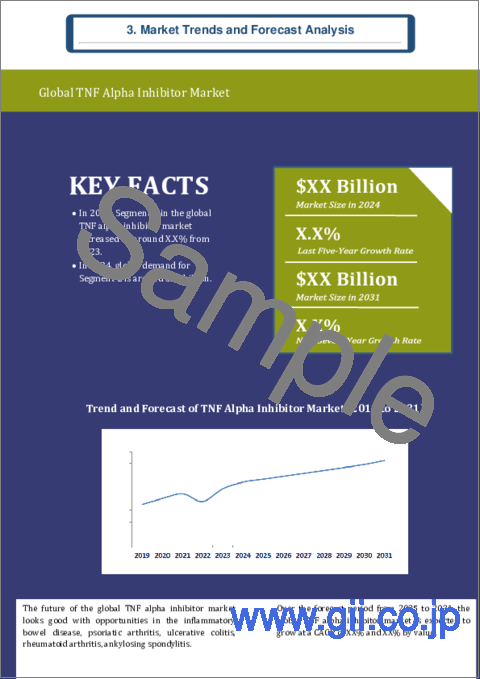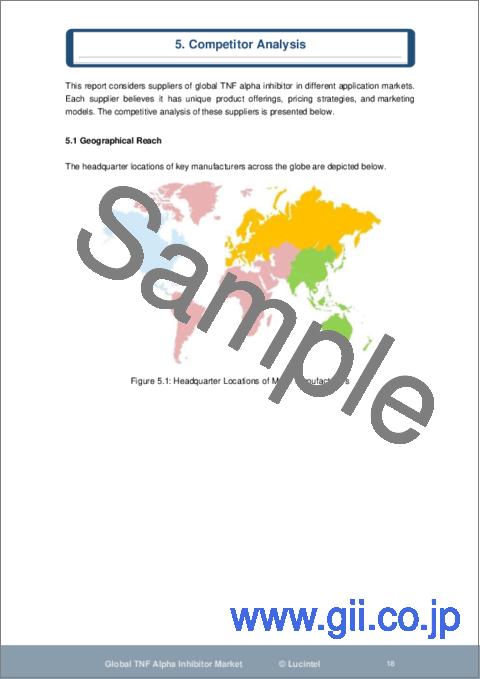|
|
市場調査レポート
商品コード
1603591
TNFα阻害剤市場レポート:動向、予測、競合分析 (2030年まで)TNF Alpha Inhibitor Market Report: Trends, Forecast and Competitive Analysis to 2030 |
||||||
カスタマイズ可能
適宜更新あり
|
|||||||
| TNFα阻害剤市場レポート:動向、予測、競合分析 (2030年まで) |
|
出版日: 2024年11月25日
発行: Lucintel
ページ情報: 英文 150 Pages
納期: 3営業日
|
- 全表示
- 概要
- 目次
TNFα阻害剤の動向と予測
世界のTNFα阻害剤市場の将来は、炎症性腸疾患、乾癬性関節炎、潰瘍性大腸炎、関節リウマチ、強直性脊椎炎市場に機会があり、有望視されています。世界のTNFα阻害剤市場は、2024年から2030年にかけてCAGR 2.4%で成長すると予想されています。この市場の主な促進要因は、炎症性疾患の発生率の上昇、バイオテクノロジー分野の進歩の増加、高齢者の増加です。
- Lucintel社の予測によると、薬剤カテゴリーでは、Remicade (インフリキシマブ) が予測期間中に最も高い成長を遂げる見込みです。
- タイプ別では、炎症性腸疾患が予測期間中に最も高い成長が見込まれます。
- 地域別では、北米が予測期間中最大の地域であり続けます。
TNFα阻害剤市場の戦略的成長機会
TNFα阻害剤市場における主要な戦略的成長機会には、以下のようなものがある:
- 自己免疫疾患の管理:関節リウマチや乾癬などの自己免疫疾患の管理におけるTNFα阻害剤の使用の増加は、大きな成長機会となります。これらの治療薬は、患者のQOLを改善すると同時に、疾患の進行を遅らせます。
- 炎症性腸疾患 (IBD) :クローン病や潰瘍性大腸炎を含むIBDの罹患率の増加は、TNFα阻害剤の需要に拍車をかけています。この領域は、特に新しい製剤やデリバリー方法の開発により、大きな成長の可能性を秘めています。
- 小児への応用:小児用TNFα阻害剤の調査により、従来の「成人専用」ガイドラインでは治療対象から除外されていた小児慢性疾患患者の治療選択肢が広がる可能性があります。小児用の承認が増えれば、この分野の治療成績が向上する可能性があります。
- 併用療法:TNFα阻害剤は、他の生物学的製剤や低分子化合物と併用することで、より高い効果が期待できます。将来的な市場拡大は、この革新的なアプローチによって推進される可能性があり、大手ブランドと中小企業との提携によって、治療経験向上のためのテーラーメイドのソリューションが開発されることになります。
- 新興市場:自己免疫疾患や炎症性疾患の罹患率が増加している新興経済諸国では、低コストのバイオシミラー医薬品が市場シェアを獲得する可能性が高いです。新興市場におけるこれらの治療薬へのアクセス拡大が成長の原動力となります。
これらの戦略は、TNFα阻害剤の市場を拡大し、技術革新を促し、治療へのアクセスを拡大することで、既存の治療法では十分な効果が得られない患者の医療ニーズに応えることになります。
TNFα阻害剤市場の促進要因・課題
技術の進歩、経済的課題、規制上の問題など、さまざまな要因がTNFα阻害剤市場に影響を与えています。これらは市場の成長と拡大を決定する重要な要素です。
TNFα阻害剤市場を牽引する要因は以下の通り:
1.自己免疫疾患の増加:自己免疫疾患の増加:自己免疫疾患の増加は、治療の一環としてTNFα阻害剤の需要を促進する重要な要因です。
2.バイオシミラーの導入:バイオシミラーの導入により治療費が削減され、TNFα阻害剤がより多くの人々にとって利用しやすくなり、市場競争も激化しています。
3.技術の進歩:ドラッグデリバリーシステムの皮下注射などの技術革新により、患者の治療成績と治療プロトコルの遵守率が向上しました。
4.支持的な規制環境:主要市場における良好な規制環境は、TNFα阻害剤の承認プロセスと市場参入を加速させています。
5.人口の高齢化:炎症や自己免疫疾患に罹患しやすい高齢者人口の増加が、TNFα阻害剤の需要拡大を牽引しています。
TNFα阻害剤市場における課題は以下の通りである:
1.市場の飽和:TNFα阻害剤の増加により市場は飽和状態にあり、製薬企業間の競争が激化し、価格圧力が高まっています。
2.バイオシミラーに対する懸念:バイオシミラー製剤は低価格であるにもかかわらず、医療従事者や一部の患者は、その有効性に対する懸念を理由に、バイオシミラー製剤の全面的な採用をためらっています。
3.規制上の障壁:TNFα阻害剤は、地域別異なる複雑な規制要件をクリアすることが、市場参入を遅らせたり、開発コストを増大させる可能性があります。
このような課題にもかかわらず、企業は市場促進要因・課題の緩和に取り組んでおり、市場は成長を続けています。
目次
第1章 エグゼクティブサマリー
第2章 世界のTNFα阻害剤市場:市場力学
- イントロダクション、背景、分類
- サプライチェーン
- 業界の促進要因と課題
第3章 市場動向と予測分析 (2018年~2030年)
- マクロ経済動向 (2018~2023年) と予測 (2024~2030年)
- 世界のTNFα阻害剤市場の動向 (2018~2023年) と予測 (2024~2030年)
- 世界のTNFα阻害剤市場:薬剤別
- Remicade (インフリキシマブ)
- Enbrel (エタネルセプト)
- Humira (アダリムマブ)
- Cimzia (セルトリズマブペゴル)
- Simponi (ゴリムマブ)
- 世界のTNFα阻害剤市場:投与経路別
- 経口
- 皮下
- 静脈内
- その他
- 世界のTNFα阻害剤市場:疾患の種類別
- 炎症性腸疾患
- 乾癬性関節炎
- 潰瘍性大腸炎
- 関節リウマチ
- 強直性脊椎炎
- その他
第4章 地域別の市場動向と予測分析 (2018年~2030年)
- 世界のTNFα阻害剤市場:地域別
- 北米のTNFα阻害剤市場
- 欧州のTNFα阻害剤市場
- アジア太平洋のTNFα阻害剤市場
- その他地域のTNFα阻害剤市場
第5章 競合分析
- 製品ポートフォリオ分析
- 運用統合
- ポーターのファイブフォース分析
第6章 成長機会と戦略分析
- 成長機会分析
- 世界のTNFα阻害剤市場の成長機会:薬剤別
- 世界のTNFα阻害剤市場の成長機会:投与経路別
- 世界のTNFα阻害剤市場の成長機会:疾患の種類別
- 世界のTNFα阻害剤市場の成長機会:地域別
- 世界のTNFα阻害剤市場の新たな動向
- 戦略的分析
- 新製品の開発
- 世界のTNFα阻害剤市場の生産能力拡大
- 世界のTNFα阻害剤市場における企業合併・買収 (M&A)、合弁事業
- 認証とライセンシング
第7章 主要企業のプロファイル
- HanAll Biopharma
- Pfizer
- Johnson & Johnson
- Janssen Biotech
- Merck
- AbbVie
- Novartis International
- Sanofi
- AstraZeneca
- GlaxoSmithKline
TNF Alpha Inhibitor Trends and Forecast
The future of the global TNF alpha inhibitor market looks promising with opportunities in the inflammatory bowel disease, psoriatic arthritis, ulcerative colitis, rheumatoid arthritis, and ankylosing spondylitis markets. The global TNF alpha inhibitor market is expected to grow with a CAGR of 2.4% from 2024 to 2030. The major drivers for this market are rising rates of inflammatory illnesses, increasing progress in the field of biotechnology, and a growing number of elderly people.
- Lucintel forecasts that, within the drug category, Remicade (infliximab) is expected to witness the highest growth over the forecast period.
- Within the type category, inflammatory bowel disease is expected to witness the highest growth over the forecast period.
- In terms of regions, North America will remain the largest region over the forecast period.
Gain valuable insights for your business decisions with our comprehensive 150+ page report.
Emerging Trends in the TNF Alpha Inhibitor Market
Emerging trends in the TNF alpha inhibitor market are reshaping its future applications and dynamics:
- Biosimilar Expansion: The global expansion of TNF alpha inhibitors is leading to lower treatment costs and better access, especially in emerging markets. This trend promotes competition, which reduces prices, making treatments more accessible for chronic conditions.
- Personalized Medicine: Advancements in genetic testing and biomarkers are driving personalized approaches to TNF-alpha inhibitor therapy. This helps optimize therapeutic efficacy and patient outcomes by tailoring therapies to individual patient profiles.
- New Indications: Ongoing research is expanding the therapeutic applications of TNF alpha inhibitors beyond traditional autoimmune diseases, including dermatology and oncology. This creates novel market opportunities and drives innovation in drug development.
- Subcutaneous Formulations: The advent of subcutaneous forms of TNF-alpha inhibitors has increased patient convenience and medication adherence. This is particularly important for chronic diseases, where long-term treatment is required, and patient compliance is crucial for improving overall well-being.
- Regulatory Harmonization: Efforts to harmonize regional regulatory frameworks have streamlined the approval process for TNF alpha inhibitors. This has sped up the time-to-market for new products and biosimilars globally.
All of these trends are shaping the TNF alpha inhibitor market in terms of accessibility, personalization, and convenience, while also driving innovation and competition in global healthcare.
Recent Developments in the TNF Alpha Inhibitor Market
Ongoing innovations and advancements in the TNF alpha inhibitor market include:
- Biosimilar Approvals: Approved TNF-alpha inhibitors in the US and Europe have intensified competition, leading to lower treatment costs and broader patient access, especially for conditions such as rheumatoid arthritis and psoriasis.
- Reforms by China's Regulatory Agency: China's regulatory reforms have expedited the approval and commercialization of both originators and biosimilars of TNF alpha inhibitors, enhancing local production capabilities and reducing dependence on imports.
- New Indications in Germany: In Germany, there is an increasing number of new indications for which approval has been granted to use TNF alpha inhibitors, including non-rheumatic inflammatory diseases. These innovations broaden the clinical usefulness of TNF alpha inhibitors.
- India's Market Expansion: The rapid introduction of affordable TNF alpha inhibitors in India, driven by the country's growing pharmaceutical industry, has improved access to these drugs for rural populations with low incomes, addressing unmet medical needs.
These strides will significantly transform the future direction of markets for critical medications like TNF alpha inhibitors, making them more affordable and accessible in a shorter period, and expanding their reach to more areas.
Strategic Growth Opportunities for TNF Alpha Inhibitor Market
Some key strategic growth opportunities in the TNF alpha inhibitor market include:
- Autoimmune Disease Management: The increased use of TNF-alpha inhibitors in managing autoimmune diseases such as rheumatoid arthritis and psoriasis presents a major growth opportunity. These therapies improve patients' quality of life while decelerating the progression of the diseases.
- Inflammatory Bowel Disease (IBD): The rising incidence of IBD, including Crohn's disease and ulcerative colitis, has spurred demand for TNF alpha inhibitors. This area offers substantial growth potential, especially with the development of new formulations and delivery methods.
- Pediatric Applications: Research into TNF alpha inhibitors for pediatric use could expand therapeutic options for children diagnosed with chronic illnesses who would otherwise be excluded from treatments under conventional "adults-only" guidelines. Increasing approvals for pediatric use could enhance outcomes in this specialty.
- Combination Therapies: TNF alpha inhibitors can have enhanced efficacy when paired with other biologics or small molecules. Future market expansion may be driven by this innovative approach, with partnerships between larger brands and smaller companies developing tailored solutions for improved treatment experiences.
- Emerging Markets: In developing economies, where the incidence of autoimmune diseases and inflammatory conditions is increasing, low-cost biosimilars are likely to capture market share. Expanding access to these therapies in emerging markets will drive growth.
These strategies will broaden the market for TNF alpha inhibitors, spark innovation, and provide greater access to therapies, addressing the medical needs of patients who are not fully served by existing treatments.
TNF Alpha Inhibitor Market Driver and Challenges
A variety of factors, including technological advancements, economic challenges, and regulatory issues, influence the TNF alpha inhibitor market. These are crucial determinants of market growth and expansion.
The factors driving the TNF alpha inhibitor market include:
1. Increasing Occurrence of Autoimmune Diseases: The rising prevalence of autoimmune diseases is a key factor driving the demand for TNF alpha inhibitors as part of the treatment process.
2. Biosimilars Adoption: The introduction of biosimilars has reduced treatment costs, making TNF alpha inhibitors more accessible to a broader population and increasing competition in the market.
3. Advancement in Technology: Innovations, such as subcutaneous injections for drug delivery systems, have improved patient outcomes and compliance with treatment protocols.
4. Supportive Regulatory Environment: Favorable regulatory environments in major markets have accelerated the approval process and market entry for TNF alpha inhibitors.
5. Aging Population: The increasing elderly population, who are more prone to inflammation and autoimmune conditions, is driving greater demand for TNF alpha inhibitors.
Challenges in the TNF alpha inhibitor market include:
1. Market Saturation: The growing number of TNF alpha inhibitors has led to market saturation, increasing competition among pharmaceutical companies and creating price pressure.
2. Concerns Over Biosimilars: Despite their lower prices, healthcare providers and some patients remain hesitant to fully embrace biosimilars, citing concerns about their efficacy, which slows their adoption rates.
3. Regulatory Barriers: Navigating complex and varying regulatory requirements across regions can delay market entry or increase development costs for TNF alpha inhibitors.
Despite these challenges, the market continues to grow as companies leverage the drivers and work to mitigate these obstacles.
List of TNF Alpha Inhibitor Companies
Companies in the market compete on the basis of product quality offered. Major players in this market focus on expanding their manufacturing facilities, R&D investments, infrastructural development, and leverage integration opportunities across the value chain. With these strategies TNF alpha inhibitor companies cater increasing demand, ensure competitive effectiveness, develop innovative products & technologies, reduce production costs, and expand their customer base. Some of the TNF alpha inhibitor companies profiled in this report include-
- HanAll Biopharma
- Pfizer
- Johnson & Johnson
- Janssen Biotech
- Merck
- AbbVie
- Novartis International
- Sanofi
- AstraZeneca
- GlaxoSmithKline
TNF Alpha Inhibitor by Segment
The study includes a forecast for the global TNF alpha inhibitor by drug, route of administration, disease type, and region.
TNF Alpha Inhibitor Market by Drug [Analysis by Value from 2018 to 2030]:
- Remicade (Infliximab)
- Enbrel (Etanercept)
- Humira (Adalimumab)
- Cimzia (Certolizumab Pegol)
- Simponi (Golimumab)
TNF Alpha Inhibitor Market by Route of Administration [Analysis by Value from 2018 to 2030]:
- Oral
- Subcutaneous
- Intravenous
- Others
TNF Alpha Inhibitor Market by Disease Type [Analysis by Value from 2018 to 2030]:
- Inflammatory Bowel Disease
- Psoriatic Arthritis
- Ulcerative Colitis
- Rheumatoid Arthritis
- Ankylosing Spondylitis
- Others
TNF Alpha Inhibitor Market by Region [Shipment Analysis by Value from 2018 to 2030]:
- North America
- Europe
- Asia Pacific
- The Rest of the World
Country Wise Outlook for the TNF Alpha Inhibitor Market
Major players in the market are expanding their operations and forming strategic partnerships to strengthen their positions. Below are recent developments by major TNF alpha inhibitor producers in key regions: the USA, China, India, Japan, and Germany:
- United States: In the US, approval of TNF alpha inhibitors has led to increased competition and reduced costs. These developments are improving access for patients, particularly for chronic diseases like rheumatoid arthritis and Crohn's disease while driving innovation in delivery mechanisms and formulation improvements.
- China: Regulatory reforms in China have fast-tracked the approval process for TNF alpha inhibitors, resulting in the launch of both local and international products. The focus is on affordability and increasing the accessibility of biological therapies for autoimmune conditions, with an emphasis on locally produced drugs.
- Germany: Biosimilar adoption in Germany has been strong, driven by favorable reimbursement policies. Recent advances include expanding the indications for existing drugs, backed by substantial clinical evidence, thereby enhancing their integration into treatment protocols.
- India: India has become a major manufacturer of low-cost TNF alpha inhibitors, with several biosimilars already available in the market. Pharmaceutical regulations have been streamlined, and efforts are now focused on improving the distribution of these treatments in rural areas and other underserved populations.
- Japan: Japan is seeing a transformation in the TNF alpha inhibitor market through the development of biosimilars and novel formulations. Recent government initiatives are promoting the use of biosimilars as cost-saving alternatives. Clinical trials are ongoing to expand the therapeutic applications of TNF alpha inhibitors in Japan.
Features of the Global TNF Alpha Inhibitor Market
Market Size Estimates: TNF alpha inhibitor market size estimation in terms of value ($B).
Trend and Forecast Analysis: Market trends (2018 to 2023) and forecast (2024 to 2030) by various segments and regions.
Segmentation Analysis: TNF alpha inhibitor market size by drug, route of administration, disease type, and region in terms of value ($B).
Regional Analysis: TNF alpha inhibitor market breakdown by North America, Europe, Asia Pacific, and Rest of the World.
Growth Opportunities: Analysis of growth opportunities in different drugs, route of administrations, disease types, and regions for the TNF alpha inhibitor market.
Strategic Analysis: This includes M&A, new product development, and competitive landscape of the TNF alpha inhibitor market.
Analysis of competitive intensity of the industry based on Porter's Five Forces model.
If you are looking to expand your business in this or adjacent markets, then contact us. We have done hundreds of strategic consulting projects in market entry, opportunity screening, due diligence, supply chain analysis, M & A, and more.
This report answers following 11 key questions:
- Q.1. What are some of the most promising, high-growth opportunities for the TNF alpha inhibitor market by drug (remicade (infliximab), enbrel (etanercept), humira (adalimumab), cimzia (certolizumab pegol), and simponi (golimumab)), route of administration (oral, subcutaneous, intravenous, and others), disease type (inflammatory bowel disease, psoriatic arthritis, ulcerative colitis, rheumatoid arthritis, ankylosing spondylitis, and others), and region (North America, Europe, Asia Pacific, and the Rest of the World)?
- Q.2. Which segments will grow at a faster pace and why?
- Q.3. Which region will grow at a faster pace and why?
- Q.4. What are the key factors affecting market dynamics? What are the key challenges and business risks in this market?
- Q.5. What are the business risks and competitive threats in this market?
- Q.6. What are the emerging trends in this market and the reasons behind them?
- Q.7. What are some of the changing demands of customers in the market?
- Q.8. What are the new developments in the market? Which companies are leading these developments?
- Q.9. Who are the major players in this market? What strategic initiatives are key players pursuing for business growth?
- Q.10. What are some of the competing products in this market and how big of a threat do they pose for loss of market share by material or product substitution?
- Q.11. What M&A activity has occurred in the last 5 years and what has its impact been on the industry?
Table of Contents
1. Executive Summary
2. Global TNF Alpha Inhibitor Market : Market Dynamics
- 2.1: Introduction, Background, and Classifications
- 2.2: Supply Chain
- 2.3: Industry Drivers and Challenges
3. Market Trends and Forecast Analysis from 2018 to 2030
- 3.1. Macroeconomic Trends (2018-2023) and Forecast (2024-2030)
- 3.2. Global TNF Alpha Inhibitor Market Trends (2018-2023) and Forecast (2024-2030)
- 3.3: Global TNF Alpha Inhibitor Market by Drug
- 3.3.1: Remicade (Infliximab)
- 3.3.2: Enbrel (Etanercept)
- 3.3.3: Humira (Adalimumab)
- 3.3.4: Cimzia (Certolizumab Pegol)
- 3.3.5: Simponi (Golimumab)
- 3.4: Global TNF Alpha Inhibitor Market by Route of Administration
- 3.4.1: Oral
- 3.4.2: Subcutaneous
- 3.4.3: Intravenous
- 3.4.4: Others
- 3.5: Global TNF Alpha Inhibitor Market by Disease Type
- 3.5.1: Inflammatory Bowel Disease
- 3.5.2: Psoriatic Arthritis
- 3.5.3: Ulcerative Colitis
- 3.5.4: Rheumatoid Arthritis
- 3.5.5: Ankylosing Spondylitis
- 3.5.6: Others
4. Market Trends and Forecast Analysis by Region from 2018 to 2030
- 4.1: Global TNF Alpha Inhibitor Market by Region
- 4.2: North American TNF Alpha Inhibitor Market
- 4.2.1: North American Market by Drug: Remicade (Infliximab), Enbrel (Etanercept), Humira (Adalimumab), Cimzia (Certolizumab Pegol), and Simponi (Golimumab)
- 4.2.2: North American Market by Disease Type: Inflammatory Bowel Disease, Psoriatic Arthritis, Ulcerative Colitis, Rheumatoid Arthritis, Ankylosing Spondylitis, and Others
- 4.3: European TNF Alpha Inhibitor Market
- 4.3.1: European Market by Drug: Remicade (Infliximab), Enbrel (Etanercept), Humira (Adalimumab), Cimzia (Certolizumab Pegol), and Simponi (Golimumab)
- 4.3.2: European Market by Disease Type: Inflammatory Bowel Disease, Psoriatic Arthritis, Ulcerative Colitis, Rheumatoid Arthritis, Ankylosing Spondylitis, and Others
- 4.4: APAC TNF Alpha Inhibitor Market
- 4.4.1: APAC Market by Drug: Remicade (Infliximab), Enbrel (Etanercept), Humira (Adalimumab), Cimzia (Certolizumab Pegol), and Simponi (Golimumab)
- 4.4.2: APAC Market by Disease Type: Inflammatory Bowel Disease, Psoriatic Arthritis, Ulcerative Colitis, Rheumatoid Arthritis, Ankylosing Spondylitis, and Others
- 4.5: ROW TNF Alpha Inhibitor Market
- 4.5.1: ROW Market by Drug: Remicade (Infliximab), Enbrel (Etanercept), Humira (Adalimumab), Cimzia (Certolizumab Pegol), and Simponi (Golimumab)
- 4.5.2: ROW Market by Disease Type: Inflammatory Bowel Disease, Psoriatic Arthritis, Ulcerative Colitis, Rheumatoid Arthritis, Ankylosing Spondylitis, and Others
5. Competitor Analysis
- 5.1: Product Portfolio Analysis
- 5.2: Operational Integration
- 5.3: Porter's Five Forces Analysis
6. Growth Opportunities and Strategic Analysis
- 6.1: Growth Opportunity Analysis
- 6.1.1: Growth Opportunities for the Global TNF Alpha Inhibitor Market by Drug
- 6.1.2: Growth Opportunities for the Global TNF Alpha Inhibitor Market by Route of Administration
- 6.1.3: Growth Opportunities for the Global TNF Alpha Inhibitor Market by Disease Type
- 6.1.4: Growth Opportunities for the Global TNF Alpha Inhibitor Market by Region
- 6.2: Emerging Trends in the Global TNF Alpha Inhibitor Market
- 6.3: Strategic Analysis
- 6.3.1: New Product Development
- 6.3.2: Capacity Expansion of the Global TNF Alpha Inhibitor Market
- 6.3.3: Mergers, Acquisitions, and Joint Ventures in the Global TNF Alpha Inhibitor Market
- 6.3.4: Certification and Licensing
7. Company Profiles of Leading Players
- 7.1: HanAll Biopharma
- 7.2: Pfizer
- 7.3: Johnson & Johnson
- 7.4: Janssen Biotech
- 7.5: Merck
- 7.6: AbbVie
- 7.7: Novartis International
- 7.8: Sanofi
- 7.9: AstraZeneca
- 7.10: GlaxoSmithKline





